
Ella at Duke's Place is a 1965 studio album by Ella Fitzgerald and Duke Ellington, accompanied by his Orchestra. While it was the second studio album made by Fitzgerald and Ellington, following the 1957 song book recording, a live double album Ella and Duke at the Cote D'Azur was recorded in 1966. Ella at Duke’s Place was nominated for Best Female Pop Vocal Performance at the 1967 Grammy Awards.
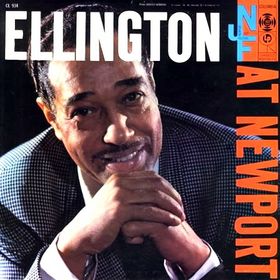
Ellington at Newport is a 1956 live jazz album by Duke Ellington and his band of their 1956 concert at the Newport Jazz Festival, a concert which revitalized Ellington's flagging career. Jazz promoter George Wein describes the 1956 concert as "the greatest performance of [Ellington's] career... It stood for everything that jazz had been and could be." It is included in the book 1001 Albums You Must Hear Before You Die, which ranks it "one of the most famous... in jazz history". The original release was partly recreated in the studio after the Ellington Orchestra's festival appearance.

Far East Suite is a 1967 concept album by American jazz musician Duke Ellington, inspired by his group's tour of Asia. Ellington and longtime collaborator Billy Strayhorn wrote the compositions.
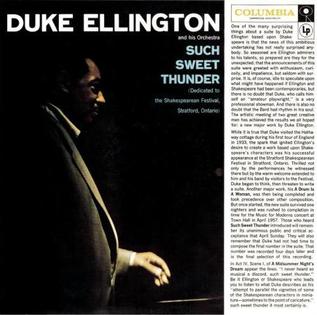
Such Sweet Thunder is a Duke Ellington album, released in 1957. The record is a twelve-part suite based on the work of William Shakespeare.

Never No Lament: The Blanton-Webster Band is a 2003 three-disc compilation combining the master takes of all the recordings by Duke Ellington's Orchestra during the years of 1940 to 1942 with an additional nine tracks, including five alternative takes and four additional masters. An expanded version of The Blanton–Webster Band, this reissue, according to Allmusic, "truly worth either an initial investment or reinvestment". All About Jazz: New York observed that these performances, from what is often considered "the band in its prime", "not only set the standard for big bands and jazz orchestras, but created an ideal near insurmountable to improve upon". The Penguin Guide to Jazz selected this compilation as part of its suggested "Core Collection."
Sacred Concert by Duke Ellington is one of the following realisations:
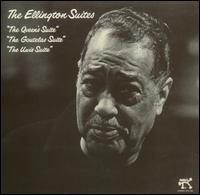
The Ellington Suites is an album by the American pianist, composer, and bandleader Duke Ellington. It collects three suites recorded in 1959, 1971, and 1972, and was released on the Pablo label in 1976. The album won a Grammy Award for Best Jazz Performance by a Big Band in 1976. Ellington and Billy Strayhorn wrote "The Queen's Suite" for Queen Elizabeth II who was presented with a single pressing of the recording, which was not commercially issued during Ellington's lifetime.
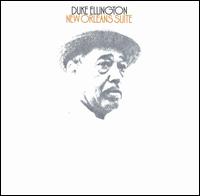
New Orleans Suite is a studio album by the American pianist, composer, and bandleader Duke Ellington, recorded and released on the Atlantic label in 1970. The album contains the final recordings of longtime Ellington saxophonist Johnny Hodges, who died between the album's two recording sessions. The album won a Grammy Award in 1971 for Best Jazz Performance by a Big Band.

First Time! The Count Meets the Duke is an album by American pianists, composers and bandleaders Duke Ellington and Count Basie with their combined Orchestras recorded and released on the Columbia label in 1961.

Blues in Orbit is an album by American pianist, composer and bandleader Duke Ellington recorded for the Columbia label in 1959 and released in 1960.

Live at the Blue Note is a live album by American pianist, composer and bandleader Duke Ellington recorded at The Blue Note nightclub in Chicago for the Roulette label in 1959.

Ellington Uptown is an album by American pianist, composer and bandleader Duke Ellington, recorded for the Columbia label in 1951 and 1952. The album was re-released on CD in 2004 with additional tracks recorded in 1947 and originally released as the Liberian Suite EP.
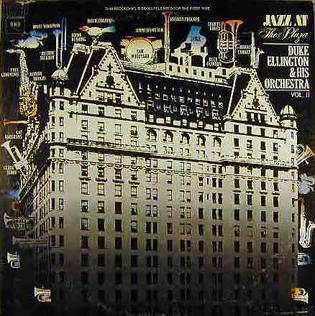
Jazz at the Plaza Vol. II is a live album by American pianist, composer and bandleader Duke Ellington recorded in 1958 at a party for Columbia Records and released on the label in 1973. The Miles Davis Sextet was also recorded at the same event and released as the first volume of Jazz at the Plaza.

The Carnegie Hall Concerts: December 1944 is a live album by American pianist, composer and bandleader Duke Ellington recorded at Carnegie Hall, in New York City in 1944 and released on the Prestige label in 1977.

The Carnegie Hall Concerts: January 1943 is a live album by American pianist, composer and bandleader Duke Ellington recorded at Carnegie Hall, in New York City in 1943 and released on the Prestige label in 1977.

The Carnegie Hall Concerts: December 1947 is a live album by American pianist, composer and bandleader Duke Ellington recorded at Carnegie Hall, in New York City in 1947 and released on the Prestige label in 1977.
"Come Sunday" is a piece by Duke Ellington, which became a jazz standard. It was written as a part of the first movement of a suite entitled Black, Brown and Beige. Ellington was engaged for a performance at Carnegie Hall on January 23, 1943, for which he wrote the entire composition. In 1958 he revised the suite and recorded it in its entirety for that year's album titled after the suite. "Come Sunday" was originally a centerpiece for alto saxophone player Johnny Hodges; the 1958 album, which contained a vocal version of the piece with new lyrics by Ellington featuring gospel singer Mahalia Jackson, greatly increased its popularity.
"Isfahan" is a jazz piece credited to Billy Strayhorn and Duke Ellington and released on Ellington's 1967 album The Far East Suite; Isfahan is a city in Iran. It features long-time Ellington soloist Johnny Hodges on alto saxophone. It was originally called Elf when Strayhorn composed it, months before the 1963 Ellington orchestra world tour during which the group traveled to Iran.

The Girl's Suite and The Perfume Suite is an album by American pianist, composer and bandleader Duke Ellington compiling recordings from 1957 and 1961 which were released on the Columbia label in 1982.

Black, Brown, and Beige, subtitled A Duke Ellington Tone Parallel to the American Negro, is a live album of phonograph records by Duke Ellington featuring the suite of the same name in live performance in 1943. Released under the Victor Showpiece designation, the album was the first release of the suite, which has primarily been perceived in retrospect as a botched attempt by Ellington to capture his feelings on race in the United States through music. Consequently, it has been studied as an interesting work highlighting Ellington's complex relationship with race relations.

















